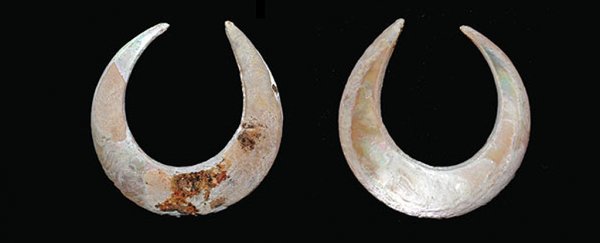Archaeologists have unearthed the oldest fish hooks found in a grave, and they're challenging the idea that most of the fishing work in the Indonesian region thousands of years ago was only carried out by men.
Dating back to the Pleistocene 12,000 years ago, the hooks were part of the grave goods of a burial on Indonesia's Alor Island, carefully arranged under the chin and around the jaw of the deceased - who the researchers think was a woman.
They're not the oldest fish hooks ever recovered - that honour goes to circular rotating fish hooks found in Okinawa, dating back 23,000 years. They are, however, the oldest found in a burial.
"These are the oldest known fish-hooks associated with mortuary practices from anywhere in the world and perhaps indicate that fishing equipment was viewed as essential for transition to the afterlife in this area," said study leader Sue O'Connor, an archaeologist at the Australian National University.
People aren't usually buried with random objects. Archaeological grave goods mean something - whether they were items owned by the person, items that they might need in the afterlife, or a combination of both purposes. But they do usually have some relationship with the person's life.
As is common for island communities, the people of Alor Island probably relied heavily on fishing for survival - indicated by the lack of other protein sources on the island.
The fish hooks seem to confirm this. In addition, the hooks in question are very finely made, indicating that the deceased was a person of status.
There were five hooks catalogued in the paper. Four of them are circular rotating hooks, made from the carved and polished shells of the commercial top-shell sea snail. They show signs of polishing to remove the outer layer to reveal the shimmering nacre beneath - perhaps to better attract fish.
They're almost circular, with one side (the shank) only slightly longer than the other, and wider in the middle, which gives the hook mechanical strength. They're not notched or drilled for a line; instead, the cord would have been lashed around the entire length of the shank and partially around the bend.
They were favoured around the world, the researchers said in their paper, for deep-sea fishing. As the name suggests, when the fish bit the hook, it would rotate in its mouth as it tried to swim away, compared to the more familiar J-shaped hooks, which need to be tugged to hook a fish.
However, the researchers propose that, rather than cultural diffusion, the hooks represent cultural convergence. In other words, the cultures that used this type of hook - which include Japan, Australia, Arabia, Mexico and Oceania - all developed it independently.
One of those J-shaped hooks was also found in the grave, broken, and the twin shell of a cockle was found under the skeleton's chin, drilled with a hole and showing evidence of once having been stained red, perhaps for a pendant.
There's also precedent for female fishers. Fish hooks dating back 1,000 years have been associated with Australian Aboriginal fisherwomen in Port Jackson, where both men and women fished - but men did the spear fishing and women did the hook-and-line fishing.
The entire skeleton couldn't be excavated, so the researchers could not be 100 percent certain it belonged to a woman, but what signs they could find indicated that it belonged to a female adult.
The also couldn't date the skeleton itself, instead radiocarbon dating charcoal that had been also found in the grave.
The research has been published in the journal Antiquity.
